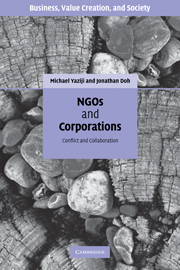Book contents
- Frontmatter
- Contents
- List of figures
- List of tables
- Preface
- Foreword
- Acknowledgments
- Part I Understanding NGOs
- Part II NGO advocacy campaigns
- 4 NGO campaigns against corporations and (de-)legitimacy
- 5 How do they do it? Understanding the power and influence of radical advocacy NGOs
- 6 NGO campaign types and company responses
- Case illustration: PETA and KFC
- Case illustration: Coca-Cola in India
- Part III Corporate–NGO engagement
- Part IV The future of corporate–NGO relations
- Index
- References
5 - How do they do it? Understanding the power and influence of radical advocacy NGOs
Published online by Cambridge University Press: 13 January 2010
- Frontmatter
- Contents
- List of figures
- List of tables
- Preface
- Foreword
- Acknowledgments
- Part I Understanding NGOs
- Part II NGO advocacy campaigns
- 4 NGO campaigns against corporations and (de-)legitimacy
- 5 How do they do it? Understanding the power and influence of radical advocacy NGOs
- 6 NGO campaign types and company responses
- Case illustration: PETA and KFC
- Case illustration: Coca-Cola in India
- Part III Corporate–NGO engagement
- Part IV The future of corporate–NGO relations
- Index
- References
Summary
The phenomenon of NGO campaigns against corporations are highly complex and cross multiple levels of analysis. NGOs are themselves constrained and enabled by the group processes and internal resource dependencies of the organization and its supporters. These group processes within the organization affect the strategic behavior of these NGOs in terms of tactic and target selection and strategic interactions between the NGO and the targeted firm at both organizational and inter-organizational levels. These inter-organizational dynamics that make up the campaign ultimately are evaluated by third-party individuals who evaluate the various claims made by both the NGO and the targeted firm. At the individual-level, they may adjust their beliefs and thereby collectively affect the legitimacy and strength of competing institutional frameworks at the society-level.
The radical NGO paradox
Extreme advocacy or “radical” NGOs are, by definition, working against the mainstream of their societies – either in terms of values and beliefs or in terms of regulatory systems – and fundamentally aim for change. As such, radical NGOs, at first blush, should not be very effective, particularly in proxy war campaigns. First, the more radical the NGO, the smaller it is likely to be and the fewer resources it is likely to be able to draw upon since it is out of the mainstream in terms of ideology and will therefore have fewer people and organizations that will be willing to support it.
- Type
- Chapter
- Information
- NGOs and CorporationsConflict and Collaboration, pp. 74 - 92Publisher: Cambridge University PressPrint publication year: 2009



